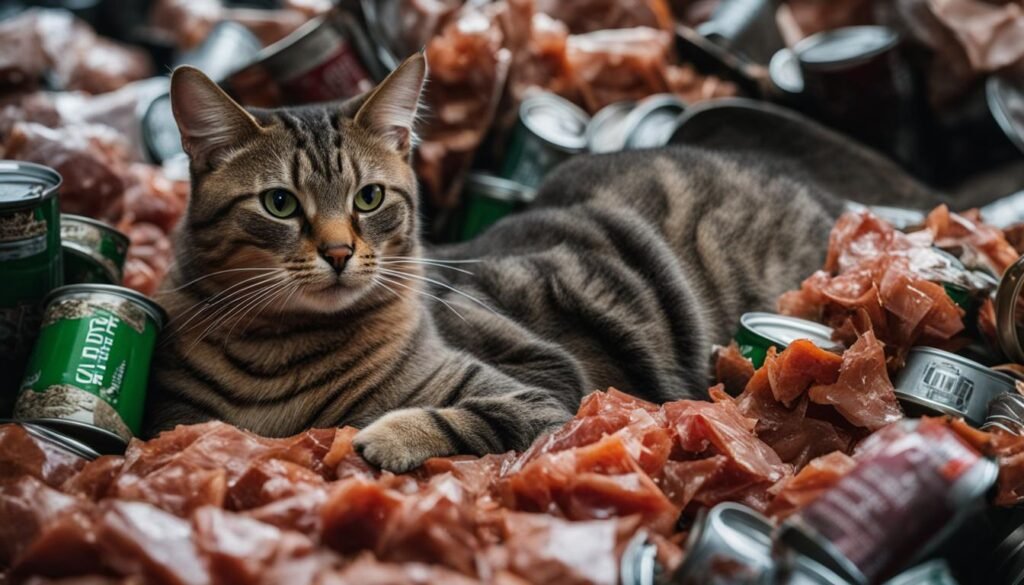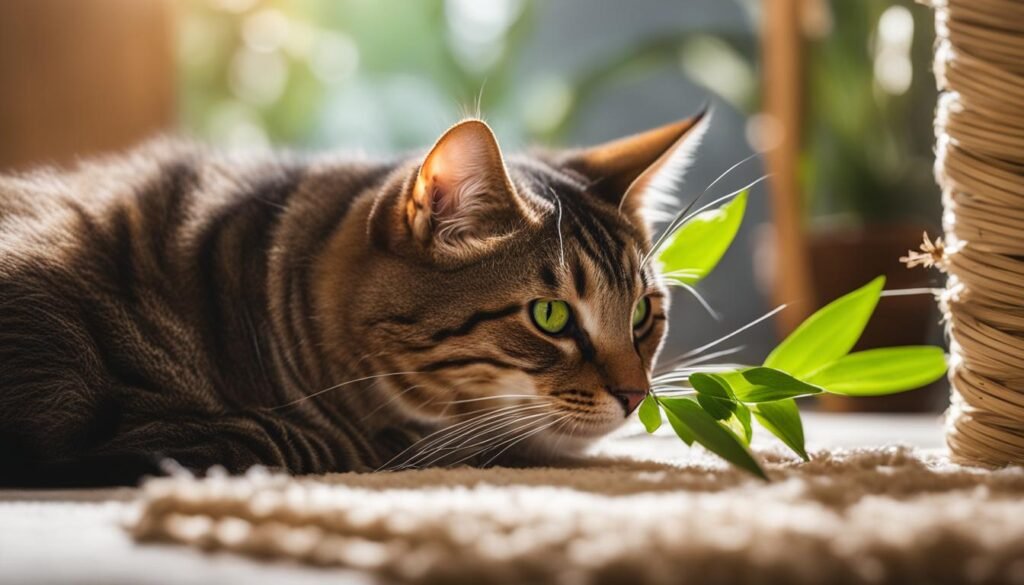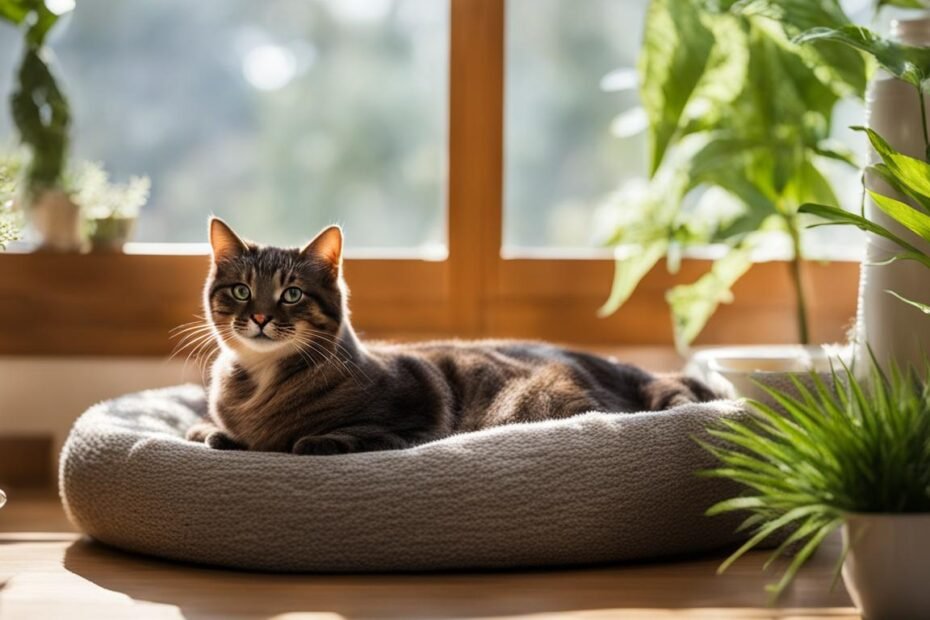Cats are beloved members of our families, but they also have an impact on the environment. From the food they eat to the waste they produce, our feline friends contribute to our carbon footprint. It’s essential to make sustainable choices for our pets to ensure their health and well-being while minimizing their environmental impact.
In this article, we will explore eco-friendly choices that can promote a healthy and sustainable lifestyle for your furry companion. By understanding the environmental impact of your cat’s diet and finding alternatives, along with proper waste disposal and eco-friendly accessories, you can create a greener future for your pet.
Key Takeaways:
- Choose eco-friendly alternatives for your cat’s food to reduce their carbon footprint
- Properly dispose of cat feces to minimize the environmental impact
- Reduce plastic waste by opting for eco-friendly pet products
- Use natural and non-toxic cleaning products for your pet’s hygiene
- Select sustainable accessories made from organic or recycled materials
The Climate Crisis and its Impact on Pets
As the Earth faces a climate crisis, it is essential to recognize the significant impact it has on our pets. Both greenhouse gas emissions and plastic waste contribute to this crisis, and cats, being obligate carnivores, play a role in these environmental challenges.
Greenhouse gas emissions are a major concern when it comes to the production of cat food. The meat industry has a substantial carbon footprint, and the production of meat for cat food contributes to the overall emissions. Additionally, plastic toys and other pet products contribute to the growing problem of plastic waste.
Understanding the implications of these issues is crucial in making informed and sustainable choices for our pets. By adopting eco-friendly alternatives, we can help reduce our pets’ environmental impact and contribute towards a healthier planet.
The Impact of Greenhouse Gas Emissions
According to research, the production of meat for cat food has a significant carbon footprint. This is because meat production, particularly beef, pork, and salmon, involves high greenhouse gas emissions. Cats, being obligate carnivores, primarily consume these types of meat, which contributes to their overall carbon footprint.
| Meat Source | Carbon Footprint (kg CO2e/kg) |
|---|---|
| Poultry | 2.1 |
| Beef | 27 |
| Pork | 12.1 |
| Salmon | 6.1 |
Table: Carbon footprints of various meat sources for cat food
Tackling Plastic Waste in Pet Products
Plastic waste is a pervasive issue, and the pet industry is not exempt from its impact. Plastic toys, bowls, and other pet products contribute to the growing problem of plastic pollution. To address this issue, it is crucial to opt for eco-friendly alternatives made from organic or recycled materials.
By choosing sustainable pet products, we can reduce our reliance on plastic and help mitigate the environmental consequences associated with its production and disposal. It is important to make conscious choices that prioritize the wellbeing of our pets and the health of the planet.
Sustainable Food Choices for Cats
When it comes to reducing the environmental impact of our cats, one area where we can make a significant difference is through their food choices. The production of meat for cat food has a high carbon footprint due to the greenhouse gas emissions associated with industrial meat production. By exploring alternative protein sources and opting for more sustainable options, we can help mitigate this impact and promote a healthier planet for our pets.
One alternative to traditional cat food is insect-based cat food. Insects are a highly sustainable source of protein, requiring significantly less land, water, and feed compared to traditional livestock. Insect-based cat food also has a lower greenhouse gas emission compared to meat-based options, making it a more environmentally friendly choice.
Another option for sustainable cat food is poultry-based products. Poultry, such as chicken and turkey, have a considerably lower carbon output compared to beef, pork, and salmon. By selecting cat food that uses poultry as the main protein source, we can further reduce the carbon footprint associated with our pets’ diets.

Comparison of Carbon Footprints
| Protein Source | Carbon Footprint (kg CO2e per kg of protein) |
|---|---|
| Beef | 26.7 |
| Pork | 12.1 |
| Salmon | 11.9 |
| Chicken | 4.6 |
| Turkey | 4.3 |
When recommending sustainable food choices for cats, it is important to consider individual dietary needs and consult with a veterinarian or veterinary nutritionist. They can help identify the best options based on factors such as age, weight, and overall health. By making informed choices about our pets’ diets, we can contribute to a more sustainable future while ensuring their health and wellbeing.
Minimizing Waste: Proper Disposal of Cat Feces
When it comes to taking care of our cats, one aspect that often goes overlooked is the proper disposal of cat feces. Cat feces can contain harmful microorganisms that pose a risk to both human and environmental health. It is essential to handle and dispose of cat waste in a responsible and environmentally friendly way.
While some may think that using cat feces as compost is a sustainable option, it is important to note that cat feces should not be used in traditional composting systems. The high levels of nitrogen and potential presence of harmful pathogens make cat feces unsuitable for general compost use. However, there are specific composting systems designed for pet waste, such as the use of dedicated pet waste compost bins. These systems ensure proper breakdown and minimize the risk of contamination.
Another important consideration in waste disposal is to avoid overfeeding our cats. Overfeeding can lead to increased waste production, which in turn contributes to a larger environmental impact. By providing our cats with the appropriate portion sizes and monitoring their food intake, we can help minimize waste production and reduce our ecological footprint.
Ultimately, responsible waste disposal is crucial for maintaining a clean and safe environment for both our cats and ourselves. By following proper procedures and utilizing specialized composting systems, we can minimize the environmental impact of cat feces and play our part in creating a more sustainable future.
Reducing Plastic Use in Pet Products
Plastic has become a global crisis, causing significant harm to our environment. As pet owners, it is crucial to minimize our reliance on plastic and seek out eco-friendly alternatives for our furry friends. By making conscious choices when it comes to pet products, we can contribute to a healthier planet and a more sustainable future.
There are numerous options available to reduce plastic use in pet products. One eco-friendly alternative is to choose toys made from organic or recycled materials. These toys are not only safer for our pets, but they also help to reduce the demand for new plastic production. Additionally, there are bowls and feeding accessories made from sustainable materials like bamboo or stainless steel, which are durable and easy to clean.
“Choosing eco-friendly pet products not only benefits the environment but also promotes the health and wellbeing of our pets.”
According to a recent study, an estimated 8 million tons of plastic enter our oceans every year, endangering marine life and ecosystems. By reducing our plastic consumption in pet products, we can play a significant role in combating this crisis and protecting our planet for future generations.
Eco-Friendly Pet Product Brands
If you’re looking for reputable brands that prioritize sustainability, consider options like Planet Dog, which offers durable dog toys made from recycled materials, or West Paw, which manufactures eco-friendly pet beds and accessories. These brands demonstrate a commitment to reducing plastic waste and promoting a greener lifestyle for pets and their owners.
| Brand | Product Range | Material |
|---|---|---|
| Planet Dog | Dog toys, feeding accessories | Recycled materials |
| West Paw | Pet beds, collars, and leashes | Recycled plastics, hemp |
| Purrfect Play | Cat toys, scratchers | Organic cotton, natural dyes |
By choosing these eco-friendly brands, we can support their efforts in reducing plastic waste and inspire other manufacturers to follow suit. Together, we can make a difference and protect our planet one pet product at a time.
Natural Cleaning and Hygiene Products for Pets
When it comes to taking care of our pets, it’s important to choose natural ingredients and eco-friendly cleaning products. Traditional cleaning products often contain harmful chemicals that can be detrimental to both our pets’ health and the environment. By opting for natural alternatives, we can ensure that our pets’ hygiene needs are met without causing harm.
Natural ingredients such as vinegar, baking soda, and lemon can be used to create effective homemade cleaning solutions. These ingredients are not only safe for our pets but also have antimicrobial and deodorizing properties. From cleaning pet bedding to disinfecting litter boxes, natural solutions can help maintain a clean and fresh environment for our furry friends.
“Using natural cleaning products not only keeps my pets safe but also gives me peace of mind knowing that I’m reducing my impact on the environment.” – Pet owner
The Benefits of Eco-Friendly Cleaning Products
Choosing eco-friendly cleaning products for pet hygiene offers several benefits. Firstly, they are free from harmful chemicals such as phthalates, chlorine, and artificial fragrances, which can be harmful to our pets’ respiratory systems. Secondly, eco-friendly products are typically made from sustainable ingredients that have a lower environmental impact compared to conventional products. By using these products, we can contribute to a cleaner and healthier planet.
Pet Hygiene Products for a Greener Future
In addition to using natural cleaning solutions, it’s also important to choose eco-friendly pet hygiene products. Look for shampoos, conditioners, and grooming products that are made from natural and organic ingredients. Avoid products that contain synthetic fragrances, dyes, and parabens, as these can be harmful to both our pets and the environment.
| Product | Description |
|---|---|
| Natural Pet Wipes | Gentle and biodegradable wipes made from plant-based materials. Ideal for quick clean-ups and refreshing your pet’s coat. |
| Organic Pet Shampoo | Made from organic and natural ingredients, these shampoos are free from harmful chemicals and gentle on your pet’s skin and coat. |
| Bamboo Pet Toothbrush | An eco-friendly alternative to plastic toothbrushes, these toothbrushes are made from sustainable bamboo and are biodegradable. |
| Biodegradable Poop Bags | Dispose of your pet’s waste responsibly with biodegradable poop bags that break down naturally in the environment. |
By choosing natural cleaning and hygiene products for our pets, we can prioritize their health and wellbeing while also reducing our environmental impact. These small changes in our pet care routines can make a big difference in creating a greener future for our furry companions and the planet.

Sustainable Choices for Pet Accessories
When it comes to our pets, making sustainable choices goes beyond their food and waste disposal. It extends to the accessories we choose for them as well. By opting for pet accessories made from sustainable materials and finding creative ways to reuse and repurpose items, we can further reduce our pets’ environmental impact.
Reusing and Repurposing
Instead of buying new accessories, consider repurposing items you already have at home. For example, old tires can be transformed into comfortable beds for your furry friends. Simply clean the tire thoroughly, add a soft cushion or blanket, and your pet will have a cozy spot to relax. Cardboard boxes can also be used as hiding spots or play areas for cats, providing them with entertainment while reducing waste.
Opting for Organic Materials
When purchasing pet accessories, look for products made from organic materials. These materials are grown without the use of harmful pesticides and chemicals, making them a safer choice for both your pet and the environment. Organic cotton toys, hemp collars and leashes, and bamboo bedding are all great options to consider.
| Material | Benefits |
|---|---|
| Organic cotton | Eco-friendly, chemical-free |
| Hemp | Durable, biodegradable |
| Bamboo | Fast-growing, renewable |
Choosing Quality over Quantity
When it comes to pet accessories, quality is key. Investing in well-made, durable products ensures that they will last longer, reducing the need for frequent replacements. Look for accessories with sturdy construction and strong materials that can withstand the wear and tear of your pet’s daily activities.
By making sustainable choices for pet accessories, we can contribute to a greener future while still providing our pets with the comfort and care they deserve.
Conclusion
In conclusion, sustainable pet care is essential for promoting a healthier and more eco-friendly lifestyle for our furry companions. By making conscious choices in their diet, waste disposal, and accessories, we can reduce their carbon footprint and contribute to a greener future.
Understanding the environmental impact of our pets and seeking out sustainable alternatives is crucial. Opting for eco-friendly pet food options, such as insect-based or poultry-based diets, can significantly lower greenhouse gas emissions compared to traditional meat-based foods.
Proper waste disposal of cat feces is also important to minimize the environmental impact. While composting pet waste is possible, it is crucial to follow guidelines and avoid using the compost on food crops due to the presence of potentially harmful microorganisms.
Choosing accessories made from organic or recycled materials, as well as reusing and repurposing items, can further reduce our pets’ environmental impact. We should also opt for natural and non-toxic cleaning products to ensure our pets’ hygiene while minimizing exposure to harmful chemicals.
By adopting an eco-friendly lifestyle for our pets, we can create a healthier and more sustainable future for them and the planet. It is crucial to educate ourselves and others about the environmental impact of pet care and make conscious choices to promote sustainability in every aspect of our furry friends’ lives.
FAQ
What is the environmental impact of cats?
Cats can have a significant impact on the environment through their food consumption and waste production.
How does cat food production contribute to greenhouse gas emissions?
The production of meat for cat food has a large carbon footprint, contributing to greenhouse gas emissions.
Are there alternative protein sources for cat food?
Yes, insect-based cat foods and poultry-based cat foods have lower greenhouse gas footprints compared to traditional options.
Can cat feces be used as compost?
No, it is not recommended to use cat feces as compost due to potentially harmful microorganisms.
How can I minimize the environmental impact of cat feces?
Proper waste disposal is important. Consider composting pet waste using specific composting systems designed for this purpose.
What should I consider when choosing pet products?
Look for eco-friendly alternatives to plastic pet products, such as toys and bowls made from organic or recycled materials.
What cleaning products should I use for pet hygiene?
Use natural and non-toxic cleaning products, like vinegar, baking soda, and lemon, to minimize exposure to harmful chemicals.
How can I make sustainable choices for pet accessories?
Choose sustainable materials, reuse and repurpose items, and opt for organic materials in toys and bedding.
Why is promoting a healthy and sustainable environment important for pets?
Making eco-friendly choices for our pets reduces their carbon footprint and contributes to a healthier planet.
